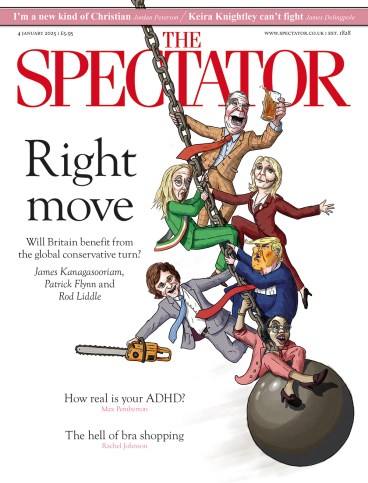
Free thinking
Sir: Your leading article (‘Article of faith’, 14 December) appears to have forgotten the connection between rationalism and natural rights. Liberals indeed think in utilitarian, Rousseauian and what they consider ‘rationalistic’ terms. But what about the logic of natural rights that come from John Rawls or Robert Nozick? The Declaration of Independence, the political culmination of Enlightenment-era thought on reason and rights, was in large part the product of irreligious minds. This document has been the model for a free society for centuries.
And what about Milton Friedman’s argument for a free society? That nobody can know with certainty what sin is; therefore, no one can coerce anybody into following his vision of whom to pray to, what one can or cannot say, or what to buy and sell. Persuade, sure, but never coerce. This is precisely a negative argument; its premise is the lack of knowledge, rather than a claim from providence.
I do not mean to downplay the cultural or historical role of Christianity in western civilisation. I simply write for those of us who do not feel completely right with the idea of leaving the principle of liberty to a leap of faith.
Maxim Nikiforov
Canberra, Australia
Broad church
Sir: A.N. Wilson (‘Church ruins’, 14 December) is right to have doubts about whether congregations in historic Christian denominations are holding up. While some larger churches and cathedrals are bucking the trend, the overall picture is one of terminal decline. However, we should not despair. Three hundred years ago, the church was in an even more parlous state. In 1740, there were only six people at the Easter Day service at St Paul’s Cathedral, every sixth house in London was a gin shop, and alcoholism, poverty, violence, murder and family breakdown were rife, as Hogarth’s prints so vividly depict.
However, a year earlier, the evangelist George Whitefield recorded in his journal: ‘Wednesday, May 2nd – Preached this evening to over 10,000 on Kennington Common. Sunday, May 6th – Preached this morning in Moorfields to about 20,000 people who were very quiet and affected… and at six, preached at Kennington. Such a sight I have never seen before. I believe there were no less than 50,000 people.’ While Whitefield may have overestimated the crowds, we cannot underestimate the effects of his and his fellow evangelist John Wesley’s preaching, which led to an explosion of growth in non-conformist churches and a reformation of society.
We will probably not witness such crowds flocking to hear Christian preachers today, but similar numbers can be found in small, often non-denominational churches and chapels all over the country. They go largely unnoticed and unreported, and they have a high percentage of ethnic minorities, asylum seekers and refugees. They may well be the powerhouses of a 21st-century revival in church and society.
Richard Coombs
Rector of Cheltenham
Building a case
Sir: Your asking the last living devotee of Le Corbusier to review my critique of post-war British architecture had a predictable result (Books, 7 December). Jonathan Meades even emigrated to France to find a house designed by his hero, who must have been responsible for more human misery than any European in peacetime.
Corbusier was a collectivist whose ideas overwhelmed town planning after the last war. He believed old cities were obsolete. Streets should be ‘killed’ and their cafes were a ‘fungus’. His followers out-destroyed the Luftwaffe, flattening swathes of urban Britain in favour of large blocks and cars. They emptied the streets of east London into bleak estates. In Liverpool they obliterated 30,000 houses which could have been restored. Corbusier had no concern for family or neighbourhood, let alone for cost.
Hundreds of thousands of ‘Corbusian’ tower and slab homes proved uninhabitable and had to be demolished. Manchester’s Hulme Crescents, Glasgow’s Red Road and London’s Heygate had to come down. Billions in public money have been spent trying to make such estates lettable. Only in the 1970s, when the movement tried to demolish Piccadilly Circus, Whitehall and Covent Garden, did the public protest.
There has never been any public inquiry into the Corbusian era. The architectural profession never investigated itself, let alone apologised. The Royal Institute of British Architects’ chairman in the 1970s, Owen Ludor, famously told critics: ‘Sod you.’ All this has long deserved exposure. Yet this is rarely done by Corbusier’s most craven worshippers, the architecture critics.
Simon Jenkins
By email
Out of proportion
Sir: Mark Kieran (Letters, 14 December) defends proportional representation on the grounds that the resulting government decisions would reflect a genuine majority, and that decision-making is not inherently binary. But a party that enjoyed genuine majority support would comfortably win under the first-past-the-post system. If on the other hand the largest party with, say, 40 per cent support formed a coalition with a party enjoying 20 per cent support, there is no reason to think the decisions of the resulting coalition would have 60 per cent support. If half the country wanted to continue driving on the left and the other half wanted to drive on the right, that would not constitute 100 per cent support for driving in the middle. However complicated and nuanced a challenge may be, the resulting decision can still often be binary.
Andrew Bent
High Wycombe, Bucks
Bar none
Sir: Martin Vander Weyer (14 December) writes: ‘I defy you to find a single negroni for a tenner anywhere these days.’ A negroni costs £10 in the Waterloo Room at the East India Club in London, and you will not taste a better one anywhere.
Tim Chesney
Saint Saviour, Guernsey







Comments